Yes, it is possible to grow a healthy, thick green lawn even in the shade.
Getting grass to grow in the shade has been a problem since residential lawns became fashionable.
Whether the shade is caused by large trees, fencing or just sun position - if your in the dark about getting grass to grow in shaded areas don't worry, it's a common problem - read on.
Top Tip:
The single most important factor when growing grass in shade is choosing the correct variety of grass.
We recommend this one, it'll grow, rain, hail shade or shine, every single time - click here for an exclusive 20% discount.
Does Grass Need Light?

Yes, grass needs light. It uses photosynthesis to convert carbon dioxide into carbohydrates. Without light, grass cannot grow - typically a healthy lawn will receive 4-6 hours or more of sunlight each day.
The amount of sunlight that reaches your lawn depends on where you live and how tall your grass is.
Longer grass will absorb more sunlight than shorter grass.
Most popular lawn seeds grow very fast especially during the Spring, Summer & early Autumn.
If you have a shaded area with little sun exposure, you may notice your grass doesn't grow as fast.
Can You Reduce the Shade?

Is your shade caused by trees, other plants or obstacles that you can move / trim? Consider pruning trees and eliminating any other obstacles that block the light from your grass.
If your grass is being shaded by a tree, you may require a tree surgeon to resolve the problem.
At the base of trees it can be difficult for grass to grow. It's competing with the tree roots for moisture and nutrients - we recommend a 1m grass free zone around the base of trees.
How to Fix Bald Patches of Grass in the Shade
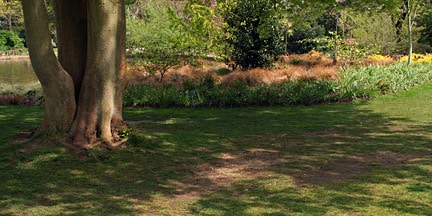
The single biggest problem with lawns that are in the shade or partially so is "bald patches" like an aging man there is no end of snake oil companies trying to sell you the next miracle cure for your loss.
Let me tell you straight... If you have bare spots in your shaded lawn, the only thing that will fix it is more grass seed, grass doesn't "spread" you can't "spray it on" - it' won't come back to life, if it's gone it's gone!
You either replace it with new grass or you let it be bald... So how do you repair bare spots of grass in a shaded area? You get the right kind of grass, prepare & be patient.
1) Get the Right Seed
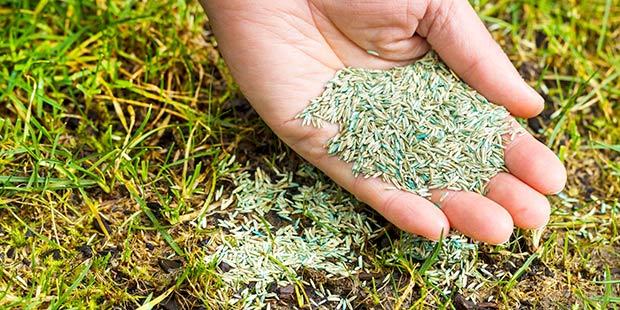
Below we will discuss the top 3 shade resistant grass seeds for the UK (click here).
If you want your grass to grow in a shaded area you will need the right type of grass seed. There are literally hundreds of different blends and varieties that will grow perfectly well in the shade.
In the UK typically you will want a blend of Ryegrass and Fescue for shaded areas. These types of grass seed are fast growing and require very little maintenance.
2) Prepare, Prepare, Prepare

Whenever your trying to repair your bald lawn the single most important step is preparation.
This is especially true when the area is shaded.
- You should ensure the soil has enough nutrition (add fertiliser & organic matter).
- You should ensure the soil is "loose" at least 2 - 3 inches deep.
- You should ensure there are no weeds, moss or dead grass in the area you wish to seed.
Once the area is prepared, spread your shade resistant grass seed and cover with 1 inch of screened top soil. Make sure the seeds have good contact with the soil and water deeply / thoroughly.
3) Keep it Moist
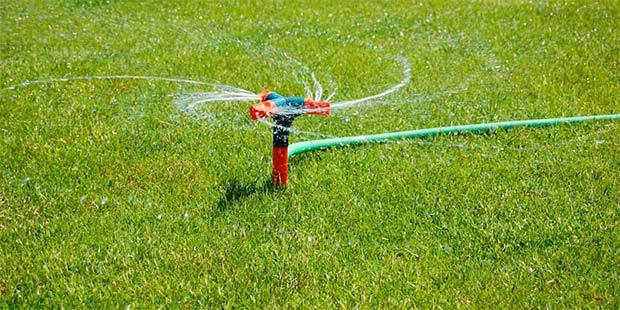
Keeping your seeds moist is definitely easier in an area with less sunlight. Less evaporation = less need for watering. It is crucial that you keep your grass seeds moist for the first few weeks.
Without moisture your new grass seed will die - the same applies in the sun or shade, it's actually easier to keep seeded areas moist in the shade rather than full sun as less water will be evaporated.
4) Be Extra Patient

As we have already discussed, grass needs sunlight to grow! The less sunlight, the slower it will grow. Typically lawn seeds will require a soil temperature above 8 degrees before they start to germinate.
In shady areas, you should expect grass to take twice as long to grow when compared to areas in full sun.
Laying or Growing a New Lawn in Shaded Areas
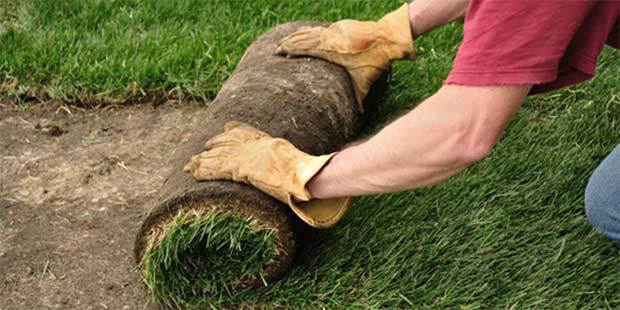
Whether you chose turf or seed or seed your biggest priority when trying to create a new lawn in the shade is choosing the correct mixture of grasses.
You can have the best preparation, rich soil and all the tools but if you don't choose the correct type of grass your new lawn will suffer.
Top 3 Shade Resistant Grass Seeds for the UK
1) Fescue Grass Mixtures
Low maintenance and slow growing, Fescue grass seeds are ideal for shady areas with poor soil health. It thrives in damp conditions and certain varieties like tall Fescue have good drought resistance.
There are hundreds of varieties of Fescue grasses, here in the UK we typically use Red Fescues. They may be the only type of grass that is able to survive dense, dry acidic shade that is typically seen under conifer trees.
2) Kentucky Bluegrass
Or smooth stalked meadow grass as we like to call it here in the UK. Bluegrass is extremely hard wearing and dense, it is cold resistant and is often combined with Fescue in the shade for denser lawn.
3) Perennial Ryegrass
Perennial Rye grass is a fast growing lawn seed that will grow pretty much anywhere. It works in the shade, full sun, poor soils - it has an eye catching, rich dark green colour, aesthetically it's everything you want in a lawn and is one of the most popular types of seed for shaded areas.
How to Keep Your Shady Lawn Healthy
It's easy to keep a lawn in full sunlight healthy, you mow it, you fertilise it, fix the bald patches and occasionally you water it but how do you keep your shady lawn healthy?
Here are 4 simple steps to keep your sun deprived grass in tip top shape:
Mow it Less Often & Less Short
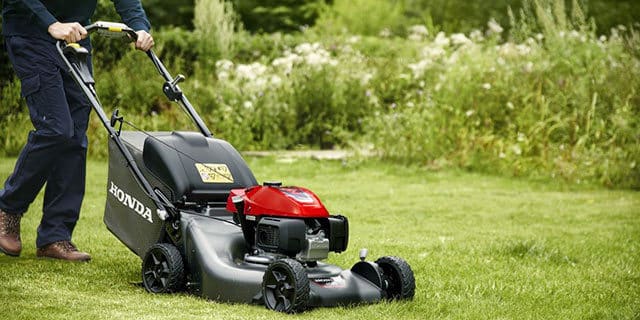
We're usually big fans of cutting the lawn often and keeping it long however with shady areas it pays to cut your lawn much less frequently and leaving the grass as high as 3inches (9cm).
If your lawn is only partially shaded then cut the bright parts as you normally would and leave the darker areas to grow a little longer. I know it will look silly but the alternative is to have a much uglier looking lawn with weeds, bare patches and moss instead of grass.
Typically we recommend you leave the grass clippings on your lawn but in shaded areas it is best to remove the clippings - they lock in moisture and won't be as easily broken down with less light.
To Water or Not to Water?

Grass in shade requires much less watering, if at all. The sun won't evaporate the water like it will on a regular lawn in full sun. A water logged, shady lawn is a recipe for moss invasion.
If your grass is shaded under trees and requires watering be sure to water thoroughly and infrequently to encourage the trees to root deeply.
Do I Have to Fertilise my Shaded Lawn?

Given that your grass will have much less sunlight it can pay big dividends to use a granular fertiliser in the Autumn months. A fertiliser high in potassium is perfectly suited for shady areas.
Most grass fertilisers are high in nitrogen which can be problematic in low sunlight. Nitrogen encourages top growth over the roots, it makes normal lawns look fantastic but in shade you want the roots of your grass to be strong which is where potassium comes into it's own.
Just throw the granules onto the lawn and ensure it is evenly spread out, the rain will do the rest. You can even get a lawn weed & feed which will kill moss and other lawn based weeds whilst at the same time fertilising your grass.
A Final Word - Beware of Moss
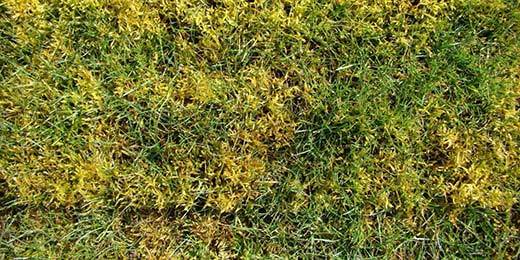
I'm not going to lie...
In shade moss is a reoccurring problem, moisture doesn't evaporate as quick and excess moisture in lawns almost always = moss...
After winter your almost always going to be dealing with moss in a shady lawn. There are many efficient and effective treatments for moss in lawns but it's a temporary fix - you can either live with it or treat it: every single year, it's not going to go away.
Why not try wild flowers instead?
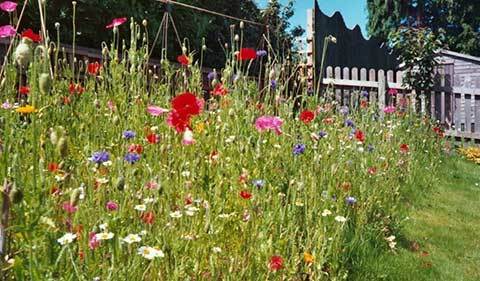
It can be tough, relentless, unending work trying to grow grass in the shade. Year, after year you will battle moss, bare patches, weeds and countless other thankless, back breaking situations.
Why not try something different?
Did you know Great Britain has lost 97% of it's natural wild flower habitat since WW2.
Yep, 97%... Ninety seven percent! Let that sink in, it's a bit scary!
Wild flowers provide food for pollinators like bees, butterflies and birds.
More than herbicides or insecticides, the loss of habitat has seriously diminished Britain's bee population.
The best part of this is that you can easily grow a wild flower "meadow" in the shaded parts of your lawn. It'll look great, it's great for the bees and it requires much less maintenance than trying to grow just "grass" in the shade - goodbye moss, hello bees!

Great info. We’ve chopped down some fir trees that were in the shade of a TPO Beech tree and are wondering the best grass or wild flowers to grow
A mix of Rye and Fescue is probably your best bet for shaded areas